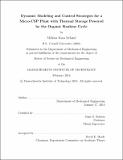Dynamic modeling and control strategies for a micro-CSP plant with thermal storage powered by the Organic Rankine cycle
Author(s)
Ireland, Melissa Kara
DownloadFull printable version (4.363Mb)
Alternative title
Dynamic modeling and control strategies for a micro-concentrating solar power plant with thermal storage powered by the ORC
Other Contributors
Massachusetts Institute of Technology. Department of Mechanical Engineering.
Advisor
John G. Brisson.
Terms of use
Metadata
Show full item recordAbstract
Organic Rankine cycle (ORC) systems are gaining ground as a means of effectively providing sustainable energy. Coupling small-scale ORCs powered by scroll expander- generators with solar thermal collectors and storage can provide combined heat and power to underserved rural communities. Simulation of such systems is instrumental in optimizing their control strategy. However, most models developed so far operate at steady-state or focus either on ORC or on storage dynamics. In this work, a model for the dynamics of the solar ORC system is developed to evaluate the impact of highly transient heat sources and sinks, thermal storage, and the variable loads associated with distributed generation. Based on an existing micro-CSP (concentrating solar power) plant, the dynamic model is implemented in the Modelica modeling language. Detailed steady-state component models, which are implemented in EES and validated to data where available, form the basis for the dynamic components. The dynamic model in its current form is used to make qualitative assessments of several control decisions based on realistic solar irradiance input representing four reference days. Future analysis will survey a wider range of environmental conditions to make quantitative determinations on the efficacy of each control decision. The simulations include an approximation for startup and shutdown, which avoids the numerical issues associated with the discontinuities in the working fluid density derivative present during such rapid phase changes. To the author's knowledge, this is the first model capable of continuously simulating through startup and shutdown in addition to coupling a dynamic thermo-dynamic model of the power cycle with dynamic models of the solar collectors and thermal storage tank.
Description
Thesis: S.M., Massachusetts Institute of Technology, Department of Mechanical Engineering, 2014. This electronic version was submitted by the student author. The certified thesis is available in the Institute Archives and Special Collections. Cataloged from student-submitted PDF version of thesis. Includes bibliographical references (pages 89-90).
Date issued
2014Department
Massachusetts Institute of Technology. Department of Mechanical EngineeringPublisher
Massachusetts Institute of Technology
Keywords
Mechanical Engineering.